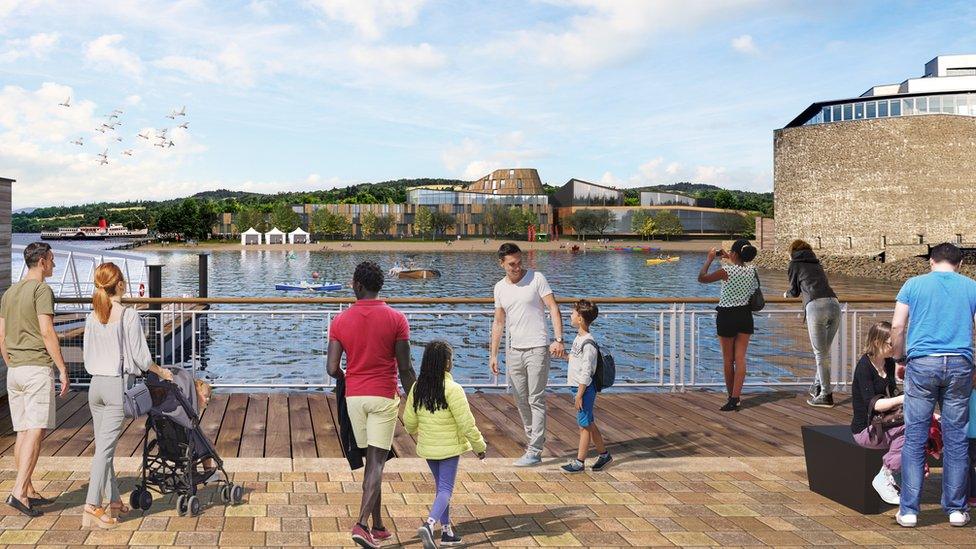Why did 55,000 people object to Loch Lomond development plans?
- Published

Developers have promised upgrades to public footpaths and green spaces in the area but locals fear they will lose access to popular routes
Proposals for a tourist resort on Loch Lomond have been complained about more than 55,000 times.
Plans for the £30m resort near Balloch are believed to have attracted the largest number of objections for a Scottish planning application.
The online petition, external against the Lomond Banks development has been passed to planners.
BBC Scotland's local government correspondent Jamie McIvor answers some questions about the proposals.
What is being proposed?
The plan is for a £30m tourist development on land close to the village of Balloch at the south of the loch. It includes a 60-bedroom apart-hotel, 32-bedroom budget hotel, craft brewery, leisure centre and restaurants.
The development has been drawn up by theme-park operator Flamingo Land Limited but it is not branded as Flamingo Land. Developers are adamant it is not a theme park. Nor, contrary to some local suggestions, is there any proposal to build rollercoasters.
It would be built on land close to both the village and the existing Lomond Shores tourist development. If it goes ahead, it could be open by 2024 and developers claim it could create almost 200 jobs.
What stage is the application at?
Final plans were submitted to the Loch Lomond and Trossachs National Park Authority last month. The developers modified previous plans in light of requests by the authority for changes and further information. The decision on whether to allow the development lies with the authority - not the local council.

A hotel, lodges and "glamping pods" form part of the plan for the site at Balloch
Why is it so controversial?
Fundamentally, the issue here is about what may or may not be considered appropriate in a national park or in one of the most beautiful areas of Scotland.
The National Park Authority has to balance a number of different factors here - for instance preserving the beauty of Loch Lomond, sustainable tourism and providing jobs for local people. Inevitably, given the love many have for Loch Lomond, many will have an opinion on the issue who do not live locally.
The extent to which this may affect the vista of the loch may be a concern to some. Critics would be concerned by any development which could affect the beauty of the area or which, they believe, may be unsympathetic to its character.
Some local residents are also concerned about the loss of an open space close to Balloch - for instance, the land is popular with dog walkers.
Supporters argue that it would be close to existing commercial developments by Balloch and not be visible at all from much of the loch side.

An artist's impression of how the development at Loch Lomond would look
Will the volume of signatures have an impact on the decision?
Obviously, the authority will be aware of the number of signatories but the sheer number alone would not be a factor.
Sometimes planning applications can attract opposition from people who are not directly affected - for instance some local authorities are aware of what appear to be "serial complaints" from those opposed to the principle of new wind farms but who do not appear to have any link with the area or the specific project.
A distinction can also be drawn between the numbers signing an online petition and any individuals or groups which submit a formal objection to a proposal.
In the case of a national park though, it is harder to argue that someone who does not live locally does not, at the very least, have a right to express an opinion. National parks are meant to be assets for the whole country - not just local residents.
Some would also argue a commercial development on this land represents the "privatisation of public space". Indeed this row seems to touch on these fundamental issues. Leading opponents include the Scottish Green MSP Ross Greer, external and the writer and champion of the outdoors Cameron McNeish.

The operators of the Flamingo Land holiday resort in North Yorkshire have lodged plans but the Loch Lomond site would not carry the same brand name
Who supports the development?
Supporters - at least of the principle - include the local community council and the charity the Friends of Loch Lomond and the Trossachs. Scottish Enterprise also supports the scheme.
Some believe that some of the objectors may be under the impression that the proposal is for a theme park - rather than for facilities which, it is argued, might broaden the area's appeal to visitors or mean that existing requirements can be better met.
The local economy around Balloch is heavily dependent on tourism - both from holidaymakers passing through the area and day-trippers.
Why isn't the local council making the decision?
The local authority, West Dunbartonshire Council, has a right to express a view on the project but will not take the decision on whether to grant it planning permission because it is within the national park's boundaries.
A spokeswoman said: "We will be making a formal response as a consultee. This will be considered by councillors in June and will thereafter be submitted to the National Park Authority as the council's response to the application."
When is a decision expected?
No date has been set.
- Published3 May 2019

- Published23 April 2019

- Published14 September 2016
